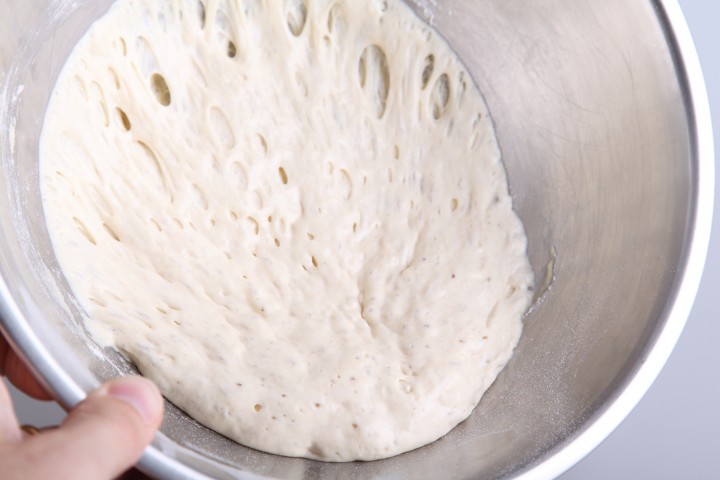
What is it?
There are several traditional methods for creating starters for breads. All of these starters are easy to prepare.
A starter usually consists of a simple mixture of wheat flour, water, and a leavening agent (typically yeast or a sourdough culture). After mixing it is allowed to ferment for a period of time, and then is added to bread dough as a substitute for, or in addition to more yeast. So pre-ferments are critical for best tasting bread – You can call it a starter, biga, poolish, preferment, or sponge – they all do sort of the same job and only really differ by water content.
Biga and poolish are terms for pre-ferments used in Italian and French baking, respectively, for sponges made with domestic baker’s yeast. Poolish is a fairly wet sponge (typically made with a one-part-flour-to-one-part-water ratio by weight), while biga is usually drier. Bigas can be held longer at their peak than wetter sponges, while a poolish is one known technique to increase a dough’s extensibility.
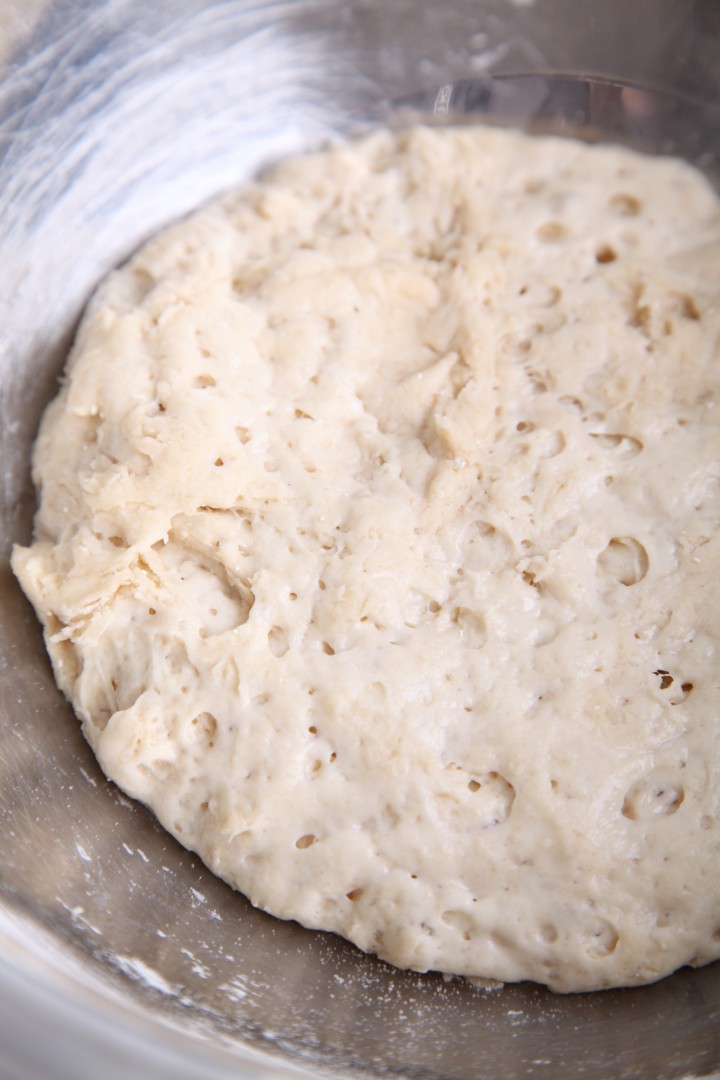
Why use it?
The primary difference between making bread with a starter and making bread with the direct or straight yeast method is that starter breads require much more time to prepare, but the flavor and texture of the bread is almost impossible to achieve with other leavening methods. Bread made with starters like poolish and biga also tends to keep better, compared to bread made from straight doughs.
Poolish & biga tips
- If you are working with pre-fermented doughs like poolish or biga make sure not to ‘over ripe’ your pre-ferment. This is especially true when using larger percentages of preferment in your final dough (think up to 50%) because over riping will kill the gluten in your preferment (the yeast will eat them all) and you will end up with a weaker and hard to handle dough.
- The higher the percentage of pre-ferment you use the more your bread crumb will have a nice chewy texture (but it stops at around 50%). We like our bread that way, it gives you something to chew on. The sugars that are released from the flour in the pre-ferment also add a nice golden colour to your bread.
- Yes you can make the same bread recipe using a biga or a poolish, you just need to make sure you adjust the water content.
- You can make a poolish or biga from another type of flour than the one you are using for the actual bread. For example, we use spelt, rye or whole wheat flour to add extra (and different) flavours to our bread.
Percentage of instant dry yeast in poolish
You can prepare your poolish up to 8 hours but also up to 16 hours in advance. But you have to adjust the amount of instant dry yeast you use. Logically, the more time a pre-ferment gets, the less yeast you have to use.
This is the schedule we use
Poolish up to 8 hours in advance – 0.23% – 0.33%
Poolish up to 12 hours in advance – 0.1% – 0.2%
Poolish up to 16 hours in advance – 0.03% – 0.08%
Example – How to calculate the right amount of yeast
You make a poolish consisting of 200 g flour and 200 g water. You make it 12 hours in advance (typically the night before the morning of baking) and it is summer or a nice warm room temperature for the poolish to ferment in.
You calculate the amount of instant yeast needed as follows:
amount-of-instant-yeast = amount-of-flour / 100 x percentage-of-table
For example;
200 g (amount of flour)
0.1% (yeast amount used in summer for 12 hour poolish)
To calculate 1% of 200g of flour you divide 200 g by 100 and multiply by amount in the table;
200 / 100 x 0.1 = 0.2 g instant yeast
(for fresh yeast multiply the amount by 3)
What does 0.1 gram of yeast look like?
To give you an idea of how tiny the amount of 0.1 gram of instant dry yeast is we have made some pictures. The third picture shows 0.1 grams of yeast in a teaspoon, the last picture shows 0.1 grams of yeast in a 1/4 teaspoon.
To give you an idea of how much instant dry yeast goes into a measuring teaspoon:
1 tsp dry yeast = 3.1 g
1/2 tsp dry yeast = 1.6 g
1/4 tsp dry yeast = 0.78 g
Also check out our recipe for pizza dough with a poolish
Find our favorite bread recipe with a sourdough culture based poolish here



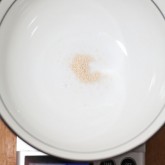
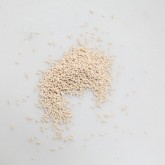
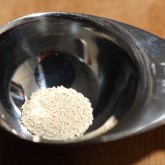
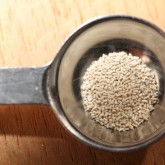

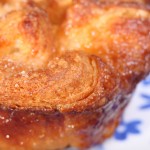
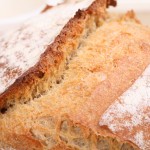

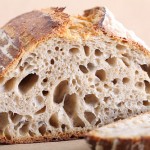
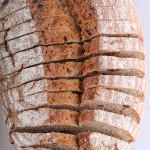
Vikas says
Very well explained to the beginners like me.
Thanks a lot it’s really nice and in detail
Gary Hopkins says
Like your article
Is there one flour best suited to make poolish with, as in protein or w factor
Thanks
Aron says
I only recently discovered using a poolish for my Neapolitan style pizza. I’m happy with the results of the recipe I used as a starter but reading this, it seems like I’m in danger of using my poolish past its prime. The recipe calls for honey but I’d like to stop to keep my doughs vegan. For an 9 ball recipe, the poolish calls for 300g/300mL and 5g yeast then a 24 hour fridge ferment. Do you have any thoughts on that? I have had some issues a) stretching a final dough to 12”. As well, I’m getting the airiness only from an additional dough ball fridge ferment of 24 hours but the dough feels weak and ready to tear sometimes. I was wondering how I could get similar airy results in a short amount of time without any cold fermentation. Thanks. Love your website.
Peter Maynard says
Hi guys, hope you are doing ok in these tough times.
I used to use your pizza poolish recipe all the time – absolutely the best ever! But it’s disappeared off your website and the link doesn’t work. Please please please post it again or send it to me! Honestly, just the simplest best recipe ever!
Christian van der Leeden says
You misspelled dough times
Jessica says
Can replace milk in the bigga dough by butter milk
Tommaso says
Hi, i’m massively late to this party, so not sure if comments are still being monitored – hope everyone is doing ok!
Possibly a stupid question here – when it comes to pizza making – If i’m going to do a long ferment (minimum 72 hours in the fridge) is there an advantage to using poolish (or biga) vs just using straight ADY? My (limited understanding) is that the poolish is there to speed up the process by adding a pre-ferment (flavour) punch to the mixture? But if ultimately i’m going to let the whole thing bulk ferment for at least 72 hours does that negate the need for poolish?
(hope you get what i mean…i’m still very new to this; lots to learn!).
Tony says
Hi…should your poolish continue to climb throughout the preferment? I am proofing for 18 hours at room temp 78F and the starter seems to always drop after 5 hours. I am copying a recipe from The Pizza Bible and prescribes 18hr room temp proof.
Grateful for your insight.
Tony
Kristian Brønsholm says
Do you have a yeast schedule for poolish that is cold fermented? I have a recepei that calls for 2% for 12-18 hours In frigde
seth wolf says
I have a complex formula and I had a few questions. I’d love to hear what you think. I have already borrowed a tremendous amount from you, so thank you so much for all your insight.
1.) I always use active dry yeast and I’m considering switching to SAF instant. Everything I’ve read says that instant yeast works faster. I prefer 12-16 hours for my poolish. Could I still get that amount of rest time if I used instant (and properly adjusted the yeast quantities). I’m also considering a blend of instant and active dry yeast for the poolish. Do you think that would be the best approach?
2.) Because I prefer long poolish development time, I’ve added a variable to my formula that adjusts the water to allow for evaporation. My formulas calculate 5-10 additional ml of water to allow for evaporation. Do you think that is an accurate assumption?
3.) I understand your warnings about over-proofing the poolish. I give it 107% initial hydration ratio (to allow for evaporation) with a relatively high yeast ratio of .23%. I always visually inspect the poolish before using it and it always looks OK. Have I just been lucky? I use a complex blend of flours in my second step, which includes high-gluten flour. Are there things I might be missing on my visual inspection? Should I be more cautious about using such a high yeast ratio for a 16-hour development time. Thank you so much for any insight you could offer.
Joe says
Hi
What percentage of poolish do you use for a final dough
Sebastiaan Reinders says
Hi,
Thanks for the great explanation. I was wondering. Why did you guys choose to also add yeast to the main dough besides from the yeast you use for the Poolish. Doesn’t that kill the whole idea of using a pre ferment? As you are adding yeast anyway to the main dough?
What would you guys recommend to only use yeast in the pre ferment and it using it in the main dough?
Weekend Bakers says
Hello Sebastiaan,
For most recipes you need both, but it depends on the recipe and the objective. You add the preferment mainly for flavor and texture and reducing of bulk fermentation, you can reduce the amount of yeast in the final dough because of it, but you still need a certain amount in the final dough to get a good rise in a yeast bread within a certain time.
Sabine says
I want to make a biga – but not with dry yeast. I’d prefer to use my sourdough starter. What percentage amount would I use to get a similar result? Would it even still be considered “biga” or does the addition of sourdough starter turn it into a “levain”? I was thinking of mixing 70g of fresh milled rye/red wheat with 5g starter & 40g water for the biga, and still add 35g of ripe starter to my dough. My reasoning for this is to see if I can bring out more sourdough flavor to the bread, but who knows… I may end up with another UFO loaf! 😉
Tina says
How do you make polish with a sourdough starter?
Do you need to use yeast with a starter?
Sabine says
I just saw this after I posted my question. 😉 I want to do this too (biga version) but I want to get away from using the dry yeast. What did you end up doing?
Weekend Bakers says
What recipe would you both use as a base? It is hard to give directions without knowing the recipe and times. One example of a recipe we have using a stiff starter (biga) is this one:
www.weekendbakery.com/posts…g-a-miche/
If you take halve of the recipe you end up with a ‘regular’ loaf of around 800 grams.
FL says
I’ve studied this page many times – thank you … my breads are already tasting better! One question: What is your Bigga yeast schedule?
Weekend Bakers says
Hello FL,
Sorry, we do not have a biga yeast schedule for you.
We do have a table % instant dry yeast that might be helpful as a base:
www.weekendbakery.com/posts…gh-recipe/
Enjoy your baking!
John Lutknic says
Hi,
I can not see any reference to temperature other than “warmer in summer” could you give a guide to temperature /time scales such as refrigerating overnight?
Weekend Bakers says
Hello John,
You can use the schedule / table with our pizza recipe for this:
www.weekendbakery.com/posts…gh-recipe/
Enjoy your baking!
Anne says
Hi, I might ask a silly question. Is country loaf with polish can be proof overnight in the fridge? I tried to proof the bread overnight in 40F fridge for 15hr but it seems a bit deflate when I score it… thanks!
Weekend Bakers says
Hello Anne,
You must realize that the proofing continues in the fridge. So 15 hours was too long in your case and it sounds like over-proofing. So look at temp and time and amount of yeast to establish how long you can retard the loaf.
Deborah Hughes says
Can you add vital wheat gluten to adjust for over-proofing? I usually use bread flour because of the higher gluten content but I am thinking of adding some vital wheat gluten. I was going to follow a recommendation that I found of 2 tbsp for each cup.
I try to keep proportions consistent but adjust flour based on its humidity.
What do you think?
Weekend Bakers says
Hello Deborah,
We would very much recommend, not to over-proof. We think the structure of the bread will still not be saved by the extra gluten.
We do not have experience with using this method to help with the issue.
We would not use it ourselves.
TEODORO S GARCIA says
can you overproof the poolish?
Could you still use an overproof poolish?
Thank you.
Weekend Bakers says
Yes, that is very much possible and using an over-proofed poolish means you use weakened, damaged gluten in your dough, which means the end result of your loaf will be less.
Greg Varjabedian says
Can this be frozen
Weekend Bakers says
What do you mean with ‘this’? The Poolish?
Nico Muller says
Just wondering, if you only use half of the Poolish that you made the previous day for your baking, can you feed it another cup each of flour and water to extend its life like a sourdough?
Weekend Bakers says
Hello Nico,
This is possible but not ideal. It depends on how much and how often you want to bake if you want to make this a regular thing. The main point is that part of the poolish will already be over-developed with weaker gluten structure when you add new flour to it. This is why we choose to make a new poolish for each recipe, so all the preferment with the flour is at the same stage of development and strength.
But if you already made it and do not want to throw it away, then you can use it the next day, in which case we would make sure it has some strength and use it sooner rather than later.
Michael Appel says
Fantastic article; thank you.
I use your technique for a 40% poolish 12-hour pre-ferment, then I make a 60% hydration dough that I use for both baguettes and New York Style pizza. I use AP flour.
The French bread dough gets an additional 24 hour cold ferment (“CF”) in the fridge. Incredible flavor (plus a killer crust from using steam for the bake).
The pizza dough gets 72 hours CF in the fridge. Crust is crisp and the crumb is airy and soft with perfect chew.
I freeze the balls in 250g portions: each one makes a nice 10″ pizza, four (4) French rolls, or a mini-baguette.
This is my secret. Shhhh…. don’t tell anyone!
Weekend Bakers says
Excellent Michael! It will be our little secret 🙂
Thank you for sharing and enjoy all your bakes
Megan says
This may be a silly question: I have prepared my poolish and the recipe calls for it to nearly triple in bulk after 12-14 hrs at room temp. It was a cool night (18 C) so this morning the poolish is only double.
Do I wait until it is tripled? Or do I go with the 14 hour time limit so as to protect the gluten?
Thanks!
Megan
Weekend Bakers says
Hello Megan,
Yes, we would use it and not wait. Always best to use slightly under-ripe than over…
Megan says
Took your advice, turned out perfectly! Thank you!
Weekend Bakers says
Great Megan, Enjoy the bread!
Gary says
Hi Marieke & Ed
I took up your suggestion from my last post and today baked you recipe for a very very tasty pain rustique. I used a rye starter. I have to say the only change I made was to bake the loaf as a boule. The outcome was amazing to look at and just as good to taste. Thank you so much for sharing your recipe!
One thing I love about bread making is the aroma, of the dough and of the baking and cooked bread. I don’t think any other cooking compares in this regard!
Thank you
Gary
Weekend Bakers says
Thank you so much for this positive feedback Gary. Excellent! Great our recipe and bit of advice could play a part in your baking success.
Keep on baking and enjoying the process, aroma and taste!
Ed & Marieke
Gary says
Just wanted to say as a novice home baker I found your article very informative and easy to read.
Thank you for taking the time/effort to post/write it. I appreciate it.
Gary
Weekend Bakers says
Hello Gary,
Thank you, much appreciated. Hope you will find our recipe of the same quality.
Enjoy your baking journey!
Marieke & Ed
Weekend Bakers
Michelle says
Hello! And thank you for the wonderful explanation! As unfashionable as it is these days, I don’t actually like sourdough, and nor does anyone I bake for particularly, they pretty much all prefer my direct method yeasted breads. So that’s what I bake! lol.
I do however use Bioreal Organic Yeast as opposed to commercial yeast. I also carry out all my bulk fermentations in the fridge for 16-24 hours, to develop the flavours and allow maximum time for gluten development. Everyone who eats them asks for them repeatedly, so I’m understandably very happy with the resultant rise/texture/flavour/appearance. I lot of people say they can eat my bread without experiencing any of the digestive upset they get when eating other yeasted loaves, so I guess I must be doing something right!
In light of my current approach, I just have a couple of questions on this topic…
1. As I already carry out an extended cold retardation at the moment, would I be likely to notice much of a change/improvement by incorporating a poolish into the preparation? I’m particularly interested regarding your comment about breads made with starters like these tending to keep better than those made with straight doughs…would that still ring true when compared to those prepared via cold retardation?
2. In my standard white loaf recipe I substitute milk for the majority of the water. I say the majority because I use fresh raw milk directly from a farm, and try as I might the fresh yeast just will not activate in it! So when using a 500g weight of my go-to strong white flour, I use 100mls of water for the yeast, plus 210mls of milk. So if I don’t use water as my liquid source does that preclude using a poolish (or biga) approach?
3. You touched on the effect that using a poolish has on the crumb texture. Am I right in thinking that its use will result in a crumb texture more akin to a sourdough loaf? Or that which you get if following the “no-knead” approach? Maybe for the kind of loaf you’d cut up to accompany soup perhaps, ie: a much coarser, more open texture, with larger holes? Rather than the smoother finer texture most preferred for a sandwich bread?
Thank you so much, in advance, for imparting your expertise. I’m intrigued to give this approach a try, but as the current one works well, I guess I’d just like an expert’s view on what I could potentially gain by incorporating it…
Many thanks from England, Michelle.
Weekend Bakers says
Thank you Michelle for your comment and your kind words. We can judge you are very much interested in the science behind the baking.
We are not sure how to answer your questions without also getting very scientific (our knowledge based on experience with cold retardation is also limited) and this prompts us to advice you to look into acquiring a good bread book with good explanations about the subject.
Bread by Hamelman is a good reference!
As for the use of milk in a poolish, we think you might find this interesting: www.thefreshloaf.com/node/…lk-poolish.
And you are right about the structure of the crumb, but it also depends on the amount of hydration and handling of the dough. The other thing that is different is the ‘bite’ and the sort of gelatinous / creamy texture it gets (but this is more noticeable with a hybrid version than a yeast based version, the first also being more complex in taste too).
Wishing you all the joy baking and good bread can give!
Greetings,
Marieke & Ed
WKB
Patricia says
Hello,
If using active dry yeast, is the equation formula the same as instant dry yeast in making the poolish?
Also, is there a time difference in the fermentation process for making the poolish?
Thank you….Patricia
Weekend Bakers says
Hello Patricia,
With our yeast converter (multi converter) you can very easy convert from instant to active dry yeast.
See: www.weekendbakery.com/cooki…nversions/
In short you need more active compared to instant, 1.2 times as much.
After using the right amount, there is no time difference, the speed of development very much depends on the temperature of the poolish.
You can also see this in more detail in the time % table that comes with our pizza recipe:
www.weekendbakery.com/posts…gh-recipe/
Enjoy your baking!
Matthieu says
Hi,
Nice article, love your website too.
I run your yeast formula against several French Poolish recipes I use, and they always use much more yeast. For example, a “pain rustique”:
poolish (6-hour fermentation)
water 250 g
flour 250 g (Rye + whole wheat + all purpose)
instant dry yeast 4 g
Your calculator tells me 0.825 g (250/100 * 0.33)
Or did I get the formula wrong?
Note: The recipes also add another 4g yeast with the dough (+ flour 250 g + water 150 g)
could you also share your temperatures? (especially for the water and your summer room temperature)
Weekend Bakers says
Hello Matthieu,
What can we say, this recipe is over 8 years ‘old’ and has been made so many times this way by many bakers. The formula is right. There is a big difference between 6 and 12 hours fermentation for the poolish, but if we would use 4 grams of instant yeast with 6 hours at room temp, we would certainly get an over-ripe over-proofed poolish.
In the end what counts is the result of course. If you get a good bread with your formula, then it works for you. But maybe just give this recipe a chance, the way we do it and see how that goes. We also tell what the temperature of the dough should be with each recipe. The poolish is fermented at room temperature which in summer for us on average means 21 to 22 Celsius. Note that you can always compensate for under-proofing, but ones something is over the top, the gluten are damaged and your dough structure and elasticity will be weak.
Also check out our tips on dough temperature:
www.weekendbakery.com/posts…mperature/
Enjoy your baking!
Melissa H says
Thank you for the detailed description of the poolish method. But I still have a question about the milk/water content.
If I turn a straight dough recipe into a poolish version, do I need to lower the amount of milk/water in the original recipe?
Thank you for your reply!
Weekend Bakers says
Hello Melissa,
If you take a straight dough recipe with 300 grams of water in it and you put 100 g in your poolish, then you add 200 g in your final dough. So together the 100 from the poolish and 200 in the final dough make 300 in total again. Same with the flour.
Enjoy your baking!
Ileana Ramirez says
This is a very illustrative page….I am a baking fan and try at least twice a week. Once, I read an article saying that by using poolish, biga or any other method for bread it gives a greater taste to it. I have also prepared a pre-fermentation for sweet breads which I think it doesn’t fit in any of those techniques, correct? So, any of those techniques can be applied to any type of bread? Many thanks,
Weekend Bakers says
Hello Ileana,
The methods are best suited for artisanal breads, where the long fermentation of the preferments make not only for tastier bread but also make it easier digestible.
It depends on what your goal is, but sweet breads are usually made to achieve a shorter ‘bite’ and finer crumb. You more often see the straight dough method or retarding of the entire dough in the fridge.
But in general you could apply it to any bread recipe, no problem.
Enjoy your baking!
liana says
Is there a way to take a recipe and figure out how to make a polish for it? So if I have a bakers scaled recipe is there a formula for converting it to one with a poolish or would you just do a autolyze when baking those recipes
Weekend Bakers says
Hello Liana,
You can turn any straight dough recipe in a version with a poolish. You look at the total amount of flour and water and decide what % you want to make into a poolish (usually between 20 and maximum 50%). Then you can use the above calculation to figure out the right amount of yeast to use corresponding with the development time for the poolish (see example). Depending on the time you want to take for the development of your final dough you can then reduce the amount of yeast in this final dough by 1/3 or maybe 1/2 (it also depends on the recipe).
Mandira says
What a brilliant and detailed explanation! So so happy ! Many thanks
Weekend Bakers says
Thank you for finding it useful Mandira.
Melissa H says
Thank you for the detailed description of the poolish method. But I still have a question about the milk/water content.
If I turn a straight dough recipe into a poolish version, do I need to lower the amount of milk/water in the original recipe?
Thank you for your reply!
Jenny Grinwis says
Hi. Should a poolish be started with mature or un-fed starter? (I.e. is the starter being fed in the making of the poolish?)
I use: 138 g flour, 170 g water and 14 g starter. I have had great results but wondered if there would be a difference if the starter was mature when making the poolish, or if the yeast will colonize the dough and weaken the gluten structure.
Weekend Bakers says
Hello Jenny,
Do you keep your starter at room temp or in the fridge and how often do you bake in a week using your starter?
Erin says
What a great source of info! Thanks for all this. I’ve been baking sourdough lately but I want to go back to yeast breads. I’m going to try your 80% hydration baguettes tomorrow.
Weekend Bakers says
Thank you so much Erin. Hope the recipe worked well, it is a bit of a challenge, this very wet dough! The video might help too.
Cartledge says
Sorry to say so but how horribly confusing!!!
Who on earth has a set of scales that weigh 0.1gm.? A laboratory perhaps.
Think this is beyond most bread makers unless they are food scientists.
Weekend Bakers says
We understand. That is why we show the amounts in the tiny teaspoons, so people without scales can see the right indication of the amount they should use. We also have a conversion page where you can fill in any amount of yeast and convert it, up to the 0.1gram.
www.weekendbakery.com/cooki…nversions/
Alternatively you can already buy precision scales for 10 to 15 dollars / euros that work well and lots of bakers that bake on a daily or weekly basis, use them, for yeast and salt.
Calvin says
I have a few questions:-
1. I am using total 300g flour for the dough, how much poolish I should create? 10%? 20% or? And those flour use in poolish has to be deducted from the total flour, right?
2. Still using the same schedule you mentioned here to calculate the amount of yeast? For example, I use 10% of total flour, 30g for the poolish, and I am going to preferment for 12 hours, 0.2% of instant yeast will be 0.06g lol
3. If I use a 12 hr preferment poolish, can I still put the dough in the fridge for cold retard overnight?
Thanks!
Weekend Bakers says
Hello Calvin,
Yes, we would suggest 20% and deduct so the total amounts of flour and water ad up.
Yes your calculation is correct but you can double this when using 20% poolish.
We are not sure under3 if you mean the poolish or the shaped loaf?